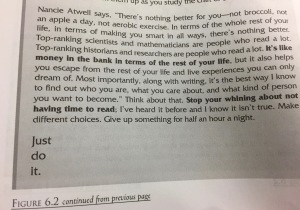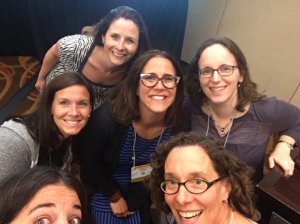I love when a book creates an opportunity that would have been impossible had it not been written. Perhaps every book has this potential, but the pages do not always open for me in this way.
Fortunately, Jhumpa Lahiri’s memoir documenting her journey learning Italian, In Other Words or In Altre Parole, fell into my hands at the perfect time. After reading it with my book club a few years ago, I happened to pop into the library and see a few piles of neatly stamped copies sitting on the desk. Stunned, I asked who  was going to be reading this somewhat unknown work of Lahiri’s.
was going to be reading this somewhat unknown work of Lahiri’s.
The Italian 4 Honors class.
I knew I had to get in on this teaching, even if only to hear what the students were saying.
Full disclosure: My own book club did not love the book. A group of Lahiri fans, this was such a departure from her lyrical storytelling that many of us struggled with it. Personally, I did not love the writing as much as I did when reading The Lowlands, but I could relate to and appreciate her dedication to learning Italian. I recognized many of the emotions that cycled through me when living in Sevilla, Spain, learning Spanish almost two decades earlier.
The main reason why I wanted to engage in reading this book with students is that I love Enia Noonan, our Italian teacher. She is a gift to the department. She not only has a true passion for the language, but even more, she deeply cares that her students understand the beauty and relevance of learning Italian. There are no textbooks in her room; rather, she is the kind of teacher who uses real china to set up cafes at tall tables where students engage in conversations in Italian. I knew she would be excited to work on this text with me.
The memoir is structured so that the English is on the right page and the Italian translation is on the left. The first year, the students read the book, slowly, digesting both the English and Italian sides. I did not speak with them until the final discussion where we talked about their experience reading a book constructed in this way.
The first thoughts that struck me were that the vast majority of the students commented on how much more they enjoyed reading the Italian than the English. They said Lahiri’s Italian was so much more beautiful, fluid, and descriptive than the English translation. I began to wonder if this was the problem my book club had while reading; none of us spoke Italian. After sharing this possible revelation with the students, we continued to have a 45-minute conversation about the book, their own experiences learning Italian, and how reading in two languages affected them.
When the bell rang, I was buzzing. The students were so engaged, thoughtful, and reflective. Many of them skipped parts of the book, or did not understand some of the ideas. But is didn’t matter in the least. All of them engaged in what Louise Rosenblatt would call an aesthetic reading of the text. They were not reading to find information, they were reading to connect to the lyrical nature of the Italian and the transactional connections they made to their own study of the language.
Enia and I sat down to plan how we wanted to use the text this year, and we knew we needed to expand upon this first experience.
One of the most interesting aspects of Lahiri’s book is that she chose to have someone else translate it for her. She writes that she did not want to break from writing in Italian, and so she decided to have someone else translate her words into English. When thinking about what we wanted our students to gain from reading the text, we knew we needed to add reflective writing and translation to their experience.
We kicked off reading the memoir with a pre-reading process that included writing, discussion, and translation. During the class, the students were able to reflect on their thoughts about learning a new language in either English or Italian, share with the class, and then translate into the other language. We were beginning with a similar process to Lahiri’s so that the students could enter the book with a mindset that mirrored much of what Lahiri would be describing.
When students began reading the book, we wanted to give them the option of which sections they would choose to read. While many chose to read the entire text, we did not feel that this was essential to the experience, so rather than some students not reading due to length, we wanted them all to feel that it was a manageable amount for them. We also wanted students to construct their own ideas from the reading, so we asked them to respond to the following questions and be prepared to discuss their thinking in class:
- What are you thinking while you read?
- What are you curious about?
- How can you relate?
- Did it remind you of anything?
- How does it feel as a reader to read in two languages?
- Did you find any memorable images in this writing?
Finally, students were asked to write a letter in Italian to Lahiri, reflecting upon what they learned from her words and connecting to their own process learning Italian. What they did not know was that someone else in the class would be translating it for them into English.
Here is where we gained even more insight into the students’ learning. Many students commented that the translation exposed mistakes that they had made in Italian. It allowed students to see when they used the wrong verb tense, or word choice, and gave them an opportunity to revise their Italian. For the translators, they had to stay as close to the Italian as possible, so they really needed to understand the linguistic components of the letter.
In her letter to Lahiri, one student reflected that, “Seeing the direct translation takes away a curtain that was hiding our shortcomings and allowing us to naively consider ourselves masters of Italian.”
Ultimately, students used this text to engage in thoughtful conversations about both Lahiri’s experiences and their own in learning a new language. For some students, this reading also evoked times when they lived in a new country, even coming to the United States. As one student wrote to Lahiri:
“This year concludes my third year of studying Italian at school, but before I studied this language in the United States I studied it in Italy. In fact, I lived there for about four years, having an elementary education in the Italian school system…I read your relationship with the Italian language and I felt somewhat nostalgic- I had a very similar experience with both English and Italian when I had just moved to respective countries.”
This was one of the unexpected joys of talking with students about In Other Words; it gave them a means for expressing ideas about culture and identity that otherwise might have continued to be hidden within them.
In the middle of this unit, the students took to national Italian exam. I happened to be walking past the room when Enia came running out and grabbed me. She was beyond excited because many of the students had chosen to write about their experience with In Altre Parole for one of the questions on the written section of the exam. As a reader and a teacher, nothing could fulfill me more than when students see a reason to think about a book beyond the walls of their classroom.
I could write pages and pages about what an incredible experience this was for us as teachers and, I think, for the students as learners. But, I will let some excerpts from the students’ letters to Jhumpa Lahiri speak instead, for they are much more powerful than mine.
“…I have a connection to what you wrote in the book. Italian is where I find happiness and tranquility. I decided to take the class at school after my grandma died. She was Italian and loved everything of Italy (the language, the food, the culture, the fashion, and more). Therefore, this language has a lot of significance in my heart.”
“I am always struck by language and culture. Your book gave me a different aspect on learning a language. I learned that it is okay to take risks. This is something that I will always keep in mind when I learn something.”
And finally…
“ This book helped me see two things: One, that I, ME, a person who values learning but often times finds it difficult, can do this. And two, that this book was not meant to teach, it was meant to empathize. Empathize with those of us who are struggling and just getting by with the language, or any language for that matter. Empathize with those of us who have been displaced and don’t quite feel at home where we are in the world. It is meant to empathize with everyone, and if this book has taught me anything, it is the knowledge that we are not alone.”
So, Ms. Lahiri, if you are reading this blog post, please be on the lookout for the package of letters that we sent you. We would be honored if you responded to our shared linguistic journey.
Grazie!









